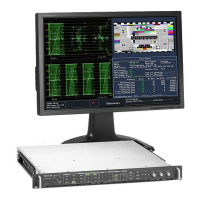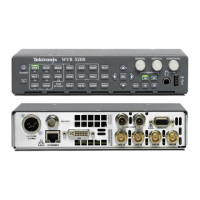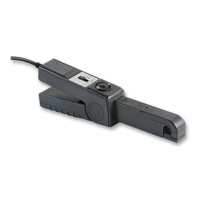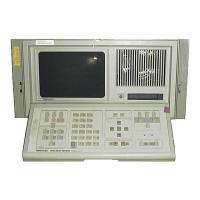General Maintenance
Major Operatio
nal or Diagnostic Failure.
Check that J6, the 60-pin connector between the Eye and Main boards, is
correctly mated and secure.
Check that the power supply cable is securely plugged into J3, the 2-pin
connector on the Eye board.
Check that the coaxial cables from the Loopthrough board to the Eye board
are secure ly connected and not crossed.
Eye Pattern or Jitter Waveform Display Problems. Jitter waveform display is
only available with Option PHY. The Eye Pattern and Jitter Waveform d isplays
are formed from data sampled from the input signal and the recovered clock
sine wave. Eye display bandwidth, rise and fall time, and transient response
aberrations depend on both the Eye and the Loopthrough boards.
When the same signal is applied to both channels, a problem that appears on one
channel but not the other indicates a faulty Loopthrough board. If the problem
appear
s on both cha nnels, then suspect a faulty Eye board. It is possible, though,
that both channels of the Loo pthrough board contain the same fault.
Cable Loss, Approx Cable, and Source Level Readout Problems. These
measurements are made by a "cable meter" circuit. This circuit is located on
the EYE board, but is largely independent from the Eye and Jitter display and
meas
urement functions. If other EYE/PHY functions operate correctly, then a
"cable meter" circuit p roblem is indicated.
Jitter Readout and Jitter Meter Problems. These measurements are derived from
sampled recovered clock sine wave data. Operation is unlikely to fail if the basic
Eye pattern display works correctly. Measurement accuracy is not a djustable, but
ji
tter noise floor depends on adjustment of Eye HD CDR calibration items.
Eye Amplitude, Eye Risetime, Eye Falltime, and Eye Rise-Fall (difference) Readout
Problems. These readouts are only available with Option PHY. T hese readouts
are derived from the Eye pattern display. Measurement accuracy depends on the
Eye Gain calibration items, and on front-end bandwidth and transient response,
which are not adjustable. Operation is unlikely to fail if the basic Eye pattern
display works correctly.
It is normal for these measurements to stop or become intermittent if there is
excessive waveform noise, aberrations, jitter, or cable loss.
4–22 WVR6020, WVR7020, and WVR7120 Waveform Rasterizers Service Manual

